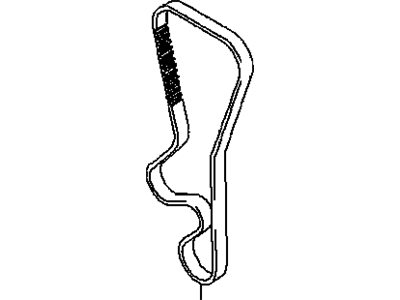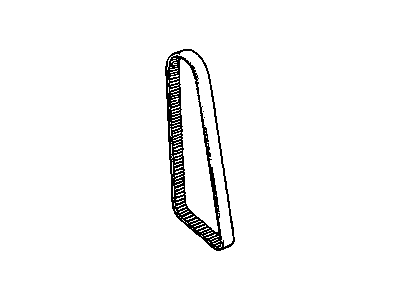ChevyParts
My Garage
My Account
Cart
OEM Cadillac Timing Belt
Engine Timing Belt- Select Vehicle by Model
- Select Vehicle by VIN
Select Vehicle by Model
orMake
Model
Year
Select Vehicle by VIN
For the most accurate results, select vehicle by your VIN (Vehicle Identification Number).
3 Timing Belts found
Cadillac Timing Belt Part Number: 95522522
$84.02 MSRP: $137.51You Save: $53.49 (39%)Product Specifications- Other Name: Belt, Engine Timing
- Replaces: 09128500, 9128500, 90530599
Cadillac Timing Belt Part Number: 55493234
$21.28 MSRP: $35.05You Save: $13.77 (40%)Ships in 1-3 Business DaysProduct Specifications- Other Name: Belt, Oil Pump; Timing Belt Kit; Belt; Belt, Engine Oil Pump
Cadillac Timing Belt Part Number: 90234902
Product Specifications- Other Name: Belt, Engine Timing; Timing Belt Kit
Cadillac Timing Belt
Want to cut long-term maintenance and repair costs? Choose OEM Timing Belt. Those parts deliver top durability you can trust. On our site, you'll find a huge catalog of genuine Cadillac parts. Prices are unbeatable, so you can keep more in your pocket. Every OEM Cadillac Timing Belt includes a manufacturer's warranty. You can also get an easy return policy that keeps buying risk free. Fast delivery, get your car on the road quickly. It's simple to search, compare, and order. Stop guessing about quality or fit. Order today and save with parts that last.
Cadillac Timing Belt Parts Questions & Experts Answers
- Q: How to replace the timing belt and what tools are necessary on Cadillac Catera?A:The necessary toolkit for Timing Belt replacement includes Timing Belt alignment kit (J 42069), crank hub torx(R) socket (J 42098), as well as supporting tools j 42069-10, j 42069-1, j 42069-2, j 42069-30, and j 42069-40. Begin by viewing cold start readings on the tool while checking for belt cracking and doing a replacement if needed. Starting the procedure by removing the intake air resonator, intake plenum and Timing Belt cover before extracting the crankshaft balancer bolts together with the balancer itself. First install the j 42069-10 to the crankshaft sprocket when the crankshaft has a clockwise rotation at 60 degrees before top dead center (BTDC). Turn the crankshaft with j 42098 until the lever of j 42069-10 contacts the water pump pulley flange to avoid positioning the crankshaft 180 degrees off tdc. First secure the lever while installing j 42069-1 and j 42069-2 on the camshaft gears after necessary adjustments. First loosen the tensioner of the Timing Belt and idler pulleys before removing the Timing Belt. Depending on the installation of your new or used Timing Belt you need to verify that the directional arrows align with the crankshaft movement. Begin Timing Belt installation at the crankshaft sprocket while using j 42069-30 tool to grasp the belt components. Place the Timing Belt inside the camshaft gear path and Timing Belt Tensioner component while maintaining correct alignment between all elements. Use j 42069-40 to check the Timing Belt deflection before applying corrections through adjustments. The initial Timing Belt tension should be set before checking alignment marks while removing the locking tools from the system. Use tool j 42098 to rotate the engine while inspecting alignment after which you need to make required changes. Finish the reassembly process by installing the crankshaft balancer then the Timing Belt cover together with the intake plenum and intake air resonator and verify no tools are left inside the engine.
- Q: How to replace the timing belt on Cadillac CTS?A:The process to replace a Timing Belt needs the use of particular tools including Timing Belt alignment kit (J 42069), crank hub torx© socket (J 42098) and additional components j 42069-10, j 42069-1, j 42069-2, j 42069-30, and j 42069-40. Any observed cracks or wear on the Timing Belt will lead to it being considered unfit for reuse. Start the replacement by taking off both the Timing Belt cover along with the crankshaft balancer. You should rotate the crankshaft clockwise using the crank hub torx© socket (J 42098) until the #1 cylinder reaches top dead center during compression stroke. The goal is to see that the reference marks on both camshaft gears line up with the notches found on both the rear Timing Belt cover and the crankshaft sprocket. The crankshaft needs to rotate counterclockwise until the crankshaft reaches 60 degrees before top dead center (BTDC) while maintaining the moveable lever toward its forward position. The Timing Belt alignment kit (J 42069-10) should be mounted onto the crankshaft sprocket while rotating the crankshaft clockwise until the tool lever touches the water pump pulley flange. This action locks the moveable lever into place. You should use the tools j 42069-1 and j 42069-2 to attach them to the camshaft gears but only after loosening the upper idler pulley when necessary for correct fit. Begin by removing the lower idler pulley combined with its adjacent spacer while also undoing the Timing Belt Tensioner nut and the upper idler pulley bolt. Experienced personnel must maintain separate bodily action on the camshaft and crankshaft to prevent their inter-sector contact. For new or used Timing Belt installation, both rotational directions must align with crankshaft motion and the belt guide marks need to be utilized for proper fit. To prevent belt jumping the sprocket teeth install the Timing Belt alignment kit (J 42069-30) while guiding the belt to enter the Timing Belt Tensioner then the camshaft gears and re-install the lower idler pulley with its spacer. Use crank hub torx© socket (J 42098) to turn the crankshaft into top dead center while applying 40 nm of torque (30 lb ft) to the lower idler pulley bolt. Sustain tension on the Timing Belt at the upper idler pulley until initial tension reaches its specified level while checking the alignment marks. After removing tools j 42069-30, j 42069-1 and j 42069-2 the mechanic rotates the crankshaft ahead to 60 degrees btdc prior to reinstallation of the Timing Belt alignment kit (J 42069-10). Secure the moveable lever while checking the reference marks alignment on both camshaft gears. The necessary adjustment steps should be followed but when no adjustment is needed final Timing Belt tension should be set before tightening the upper idler pulley bolt to 40 nm (30 lb ft). The maintenance process concludes by uninstalling tools j 42069-10 and j 42069-20 followed by reinstallation of the crankshaft balancer and Timing Belt cover.


















